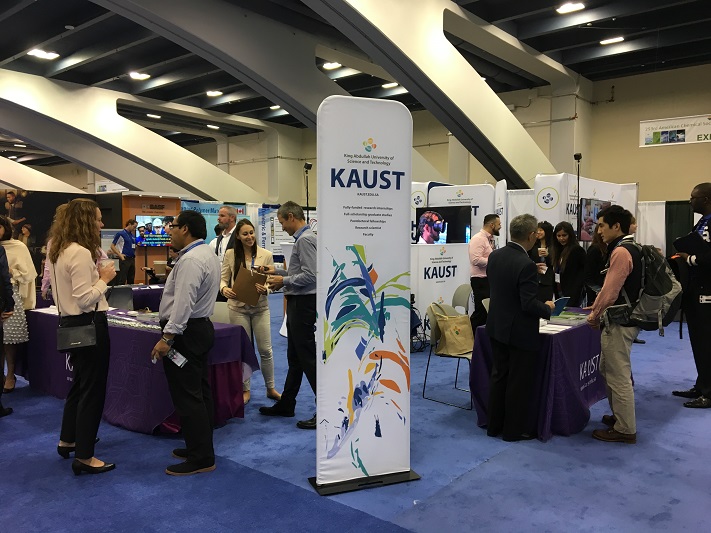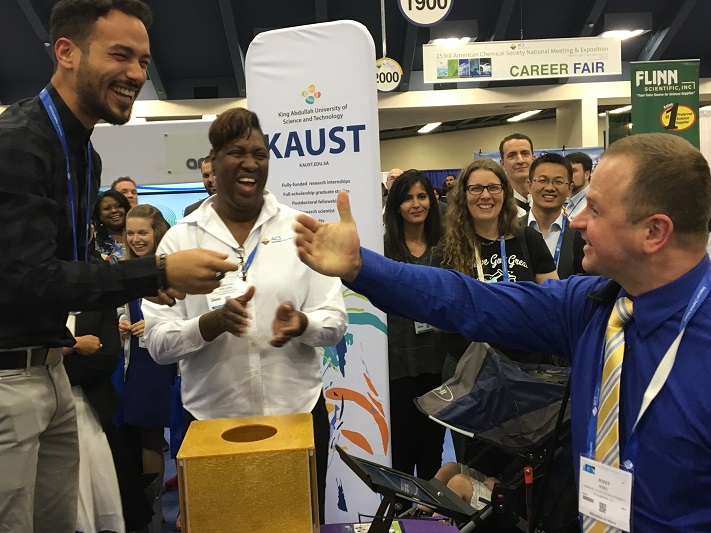KAUST draws a crowd

The KAUST booth at the 2017 American Chemical Society conference in San Francisco drew potential students and staff in to explore all that the University has to offer.
With nearly 19,000 attendees, the 253rd American Chemical Society (ACS) National Meeting and Exposition held from April 2 to 4 in San Francisco surpassed all previous attendance records. KAUST too exceeded all previous records with an action-packed plan of activities, speaking engagements, live video and more at the event, which resulted in nearly 600 people registering at the University's ACS booth and expressing an interest in learning about KAUST.

ACS San Francisco brought together the talents of a number of departments across the University, including the Physical Science and Engineering Division (PSE), the Core Labs, Human Resources, Marketing Communications and the Visiting Student Research Program (VSRP).
This diverse multi-department combination made up of over a dozen students, postdoctoral fellows, faculty and staff created an ideal atmosphere and boosted interaction with attendees.
A high percentage of ACS attendees are students, so it’s no surprise that the University's fully funded fellowships and the VSRP caused the biggest stir. The VSRP paid internship program is for students who are finishing a bachelor's or master's degree and are looking for the chance to work on an active research project in their field.
The KAUST Core Labs consist of 10 laboratories ranging from Analytical Chemistry to Imaging and Characterization to Supercomputing. These labs are used by the KAUST research community, collaborators and industry partners and are the heart that keeps research pumping at the University.
An example of the Core Labs in action is the recent high-quality sequence of the Chenopodium quinoa genome. The Analytical Chemistry Core Lab developed the method to quantify the contents of saponins in quinoa seeds. The Imaging and Characterization Core Lab generated images for the research and the Greenhouse Core Lab provided plant care. It’s the combination of talent, passion and equipment that made the research possible.
There are currently a number of open positions in the labs, including: Analytical Chemist, Chromatography & Mass Spec. Team Lead and Physical Characterization Scientist.

Professor Mohamed Eddaoudi, the Chemical Science program chair at KAUST, is well-known in the chemistry community. He is regarded as a world leader in the field of metal-organic frameworks (MOFs), and many students dropped by the booth hoping to see or speak with him.
Overall, the KAUST team was impressed with turnout this year to ACS San Francisco and the University is already starting to plan for the Fall 2017 ACS event in Washington, D.C.
-By Michelle Ponto, KAUST News
With nearly 19,000 attendees, the 253rd American Chemical Society (ACS) National Meeting and Exposition held from April 2 to 4 in San Francisco surpassed all previous attendance records. KAUST too exceeded all previous records with an action-packed plan of activities, speaking engagements, live video and more at the event, which resulted in nearly 600 people registering at the University's ACS booth and expressing an interest in learning about KAUST.

Director of the KAUST Core Labs, Justin Mynar, spoke to potential students and staff during the 2017 ACS conference in San Francisco.
ACS San Francisco brought together the talents of a number of departments across the University, including the Physical Science and Engineering Division (PSE), the Core Labs, Human Resources, Marketing Communications and the Visiting Student Research Program (VSRP).
This diverse multi-department combination made up of over a dozen students, postdoctoral fellows, faculty and staff created an ideal atmosphere and boosted interaction with attendees.
Fellowships and visiting research students
ACS San Francisco kicked off with a Graduate Fair that took place on April 2 from 1:00 to 5:00 p.m. Over 150 undergraduates signed up to learn more about the VSRP and even more stopped by to inquire about KAUST, including representatives from other schools in attendance at the event.A high percentage of ACS attendees are students, so it’s no surprise that the University's fully funded fellowships and the VSRP caused the biggest stir. The VSRP paid internship program is for students who are finishing a bachelor's or master's degree and are looking for the chance to work on an active research project in their field.
Seeking research and lab talent
In addition to future graduate students, ACS also attracts talented lab technicians and researchers who may be interested in working in the University’s high-tech labs.The KAUST Core Labs consist of 10 laboratories ranging from Analytical Chemistry to Imaging and Characterization to Supercomputing. These labs are used by the KAUST research community, collaborators and industry partners and are the heart that keeps research pumping at the University.
An example of the Core Labs in action is the recent high-quality sequence of the Chenopodium quinoa genome. The Analytical Chemistry Core Lab developed the method to quantify the contents of saponins in quinoa seeds. The Imaging and Characterization Core Lab generated images for the research and the Greenhouse Core Lab provided plant care. It’s the combination of talent, passion and equipment that made the research possible.
There are currently a number of open positions in the labs, including: Analytical Chemist, Chromatography & Mass Spec. Team Lead and Physical Characterization Scientist.

KAUST staff member Mohamed Matar interacts with visitors to the KAUST booth during the 2017 ACS conference in San Francisco.
The future is bright
With the University's top ranking globally in citations per faculty, visitors to the booth were already aware of the University’s reputation for research excellence.Professor Mohamed Eddaoudi, the Chemical Science program chair at KAUST, is well-known in the chemistry community. He is regarded as a world leader in the field of metal-organic frameworks (MOFs), and many students dropped by the booth hoping to see or speak with him.
Overall, the KAUST team was impressed with turnout this year to ACS San Francisco and the University is already starting to plan for the Fall 2017 ACS event in Washington, D.C.
-By Michelle Ponto, KAUST News

